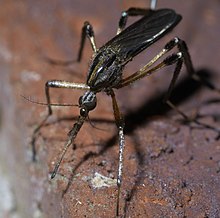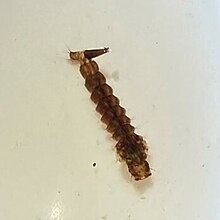| Psorophora ciliata | |
|---|---|

| |
| Female | |

| |
| Larva | |
| Scientific classification | |
| Domain: | Eukaryota |
| Kingdom: | Animalia |
| Phylum: | Arthropoda |
| Class: | Insecta |
| Order: | Diptera |
| Family: | Culicidae |
| Genus: | Psorophora |
| Species: | P. ciliata |
| Binomial name | |
| Psorophora ciliata Fabricius, 1794 | |

| |
| Range of P. ciliata north of Mexico | |
| Synonyms | |
| |
Psorophora ciliata is a species of large mosquito indigenous to North America east of the continental divide. It is one of thirteen species of the genus that reside in the continental United States. The mosquito has been referred to as the “gallinipper” or “shaggy-legged gallinipper” due to its tendency for aggressive behavior.
Range
Psorophora ciliata occurs east of the Continental Divide of the Americas with a range from South Dakota south to Central America and east to Quebec and Florida. In South America, P. ciliata can be found in tropic or temperate environments. These insects may live for up to two years from birth.
Visual characteristics
Psorophora ciliata are relatively large mosquitoes compared to other species within the genus, with a wingspan of 7-9 mm. Males and females are large and yellow-colored. The proboscis is yellow with a black tip. The abdomen is pale with a paler tip. The thorax is dark brown with a thin, bright yellow stripe which goes down the middle with two dark stripes on each side. The most common way to tell the P. ciliata apart from other species is their banded “shaggy” legs. Like all mosquitoes, the males have bushy antennae and the females do not.
Behavior
Not only are these mosquitoes aggressive towards humans and other animals as adults, but P. ciliata larvae are known for preying on other mosquito species' larvae and even tadpoles. Campos, Fernandez, and Sy found in their 2004 study that P. ciliata were frequent predators to the mosquito species Ochlerotatus albifasciatus in Buenos Aires, Argentina and impact the populations of O. albifasciatus. Females are aggressive, preferring to feed on large mammals, and are most active during spring and summer in woodlands or fields during the day or night. They lay eggs either as single eggs on moist soil, or as an egg raft on top of ephemeral pools of water. Typically, females in the genus are capable of laying their eggs on dry or damp land to hatch months or years later, depending on the species.
References
- ^ Ragasa, Ephraim V. "A mosquito Psorophora ciliata (Fabricius) (Insecta: Diptera: Culicidae)". Entomology and Nematology Department, University of Florida. Retrieved 1 June 2013.
- ^ "Mosquitoes". Vector Biology and Vector-Borne Diseases. Purdue University. Retrieved 1 June 2013.
- ^ Evans, Arthur V. Field Guide to Insects and Spiders of North America. Sterling Publishing Co., Inc. New York, NY. 2008.
- ^ Harbach, Ralph. “Psorophora.” Mosquito Taxonomic Inventory. 2008. Retrieved 11 June 2013.
- Campos, Raul E., Liliana A Fernandez, and Victoria E. Sy. “Study of the insects associated with the floodwater mosquito Ochlerotatus albifasciatus (Diptera: Culicidae) and their possible predators in Buenos Aires Province, Argentina.” Hydrobiologia 524: 91-102. 2004. Retrieved 1 June 2013.
External links
- Psorophora ciliata on the UF / IFAS Featured Creatures website.
| Taxon identifiers | |
|---|---|
| Psorophora ciliata | |